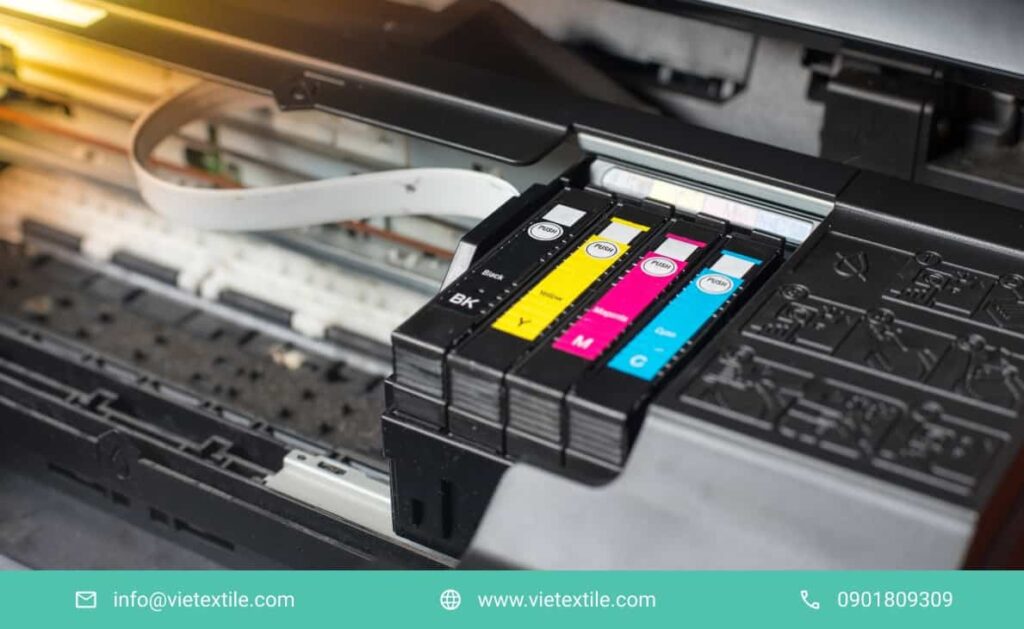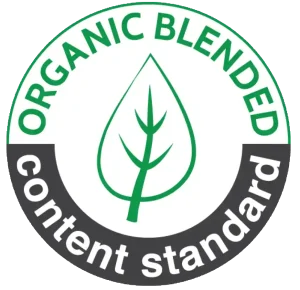In the digital textile printing industry, the quality of the print depends heavily on the condition of the ink. Cotton textile ink, in particular, is a sensitive material easily affected by the external environment. Sedimentation and precipitation are constant threats, leading to print head clogging, reduced color quality, and significant economic damage.
VieTextile understands that mastering ink storage techniques is not just about saving costs; it is about protecting your entire machinery system. This article delves into the scientific standards and practical tips for precisely storing cotton textile ink, ensuring the ink remains in a perfectly liquid state and ready for all production needs. We will explore everything from the chemical nature of the ink and optimal environmental parameters to daily operational procedures to combat sedimentation.

1. Understanding the Chemical Nature of Cotton Textile Ink
Nội dung tóm tắt
ToggleTo effectively store cotton textile ink, one must first understand its composition and properties. Sedimentation occurs when solid particles or non-dissolved chemical components settle at the bottom of the container due to gravity.
Textile inks are typically complex suspension or solution systems. Pigment inks contain solid color particles; Reactive inks contain dissolved dyes and auxiliary components. Regardless of the type, keeping these components evenly dispersed in the vehicle (solvent) is a prerequisite for ensuring print quality. If sedimentation occurs, the color concentration will be uneven, and worse, large deposits will damage the circulation system and the print head.
1.1. Classification of Cotton Inks and Factors Causing Sedimentation
The cotton textile ink market primarily uses two main types of ink, each with different sedimentation risks:
1.1.1. Pigment Ink and Flocculation
Pigment ink contains solid color particles dispersed in a solvent. These particles are insoluble and are kept suspended by dispersants.
Risk of Sedimentation: Very high. If not regularly shaken or stirred, the pigment particles will quickly settle. This sediment is very difficult to fully re-disperse, leading to color differences and permanent blockage in the ink lines or nozzles. This phenomenon is also known as “flocculation,” where individually dispersed particles begin to clump together into larger masses.
1.1.2. Reactive Ink and Precipitation Risk
Reactive ink contains fully dissolved colorants (dyes). However, they also contain other components such as pH regulators, antifungal agents, and other chemical substances.
Risk of Sedimentation: Lower than Pigment, but still possible. Changes in temperature or pH can cause the precipitation of insoluble chemical components or reduce the solubility of the dye. Additionally, salt crystals (if present) can settle. Premature hydrolysis of the Reactive dye in a high-humidity environment can also create insoluble byproducts that lead to sedimentation.
1.2. Sedimentation Mechanism and Impact on Print Heads
Sedimentation is not just an aesthetic problem; it is the core cause of equipment failure. When cotton textile ink is subjected to sedimentation, the deposits, when pumped back into the circulation system, will cause:
Nozzle Clogging: Sediment particles larger than the nozzle orifice size (often just a few picoliters) will cause clogging. This reduces the number of working nozzles, leading to horizontal streaks, poor definition, or color loss in the print. Mechanical Damage: Hard sediment can cause abrasion to the ink pump, filters, and other sensitive parts in the ink delivery system. Reduced Color Quality: The pumped ink has a lower color concentration than the standard because the color particles have settled, resulting in dull prints and color deviation.
1.3. The Role of Stabilizers and Dispersants
The stability of cotton textile ink depends on critical additives:
1.3.1. Dispersants
In Pigment ink, dispersants surround each pigment particle, creating electrostatic or steric hindrance forces between the particles. This repulsion prevents the color particles from clumping together and keeps them suspended in the solvent. If the temperature is too high or the ink is contaminated, this protective layer can be broken, leading to rapid aggregation and sedimentation.
1.3.2. pH Stabilizers
pH plays a vital role in maintaining the ionization state of ink components. For Reactive ink, an optimal pH is necessary to prevent premature hydrolysis. For Pigment ink, stable pH helps maintain the efficiency of the dispersants. pH changes (often due to prolonged exposure to air or contamination) can cause components to precipitate and are a leading cause of sedimentation.
1.3.3. Humectants
Humectants (like Glycol) help keep the ink moist, preventing it from drying out quickly at the print head nozzles. They also help maintain the viscosity of cotton textile ink within a stable range, counteracting water evaporation, thereby reducing the risk of precipitation and sedimentation.
2. Environmental Control: Optimal Temperature and Humidity
The storage environment is a decisive factor in the stability of cotton textile ink. Inappropriate temperature and humidity can alter the viscosity and promote undesirable chemical reactions, leading to sedimentation.
2.1. Importance of Ideal Temperature and Viscosity Management
Temperature is the number one enemy of cotton textile ink if not controlled.
Temperature Too High: Accelerates the evaporation rate of solvents (water, glycol). As the solvent evaporates, the concentration of the remaining Pigment particles or Reactive components increases, leading to higher viscosity. This makes the ink difficult to flow through the print head and prone to precipitation, causing sedimentation.
High temperatures can also promote chemical decomposition of the ink. Temperature Too Low: Significantly increases the ink’s viscosity. The ink becomes “thicker,” harder to pump or stir, facilitating faster settling of particles. Ideal Temperature: The ideal temperature range for storing cotton textile ink is typically 20C to 25C (68F to 77F). This temperature helps maintain stable viscosity and slows the evaporation process. The storage area should be equipped with air conditioning and a data logger to monitor temperature fluctuations 24/7.
2.2. Humidity Control to Avoid Solvent Evaporation and Thermal Shock
The surrounding air humidity also indirectly affects the sedimentation process:
Low Humidity: Causes rapid water evaporation from the ink surface (if the bottle is not perfectly sealed), increasing the concentration of solid particles and leading to sedimentation and skinning on the surface. High Humidity: High humidity can cause water vapor condensation inside the ink bottle when the temperature changes, altering the chemical composition of the ink and promoting precipitation reactions. Optimal Humidity: Maintain relative humidity in the storage warehouse between 40\% and 60\%. The combination of stable temperature and humidity helps create a “temperate” environment for cotton textile ink.
2.3. Avoiding Thermal Shock and Sunlight
Thermal Shock: Sudden temperature changes (e.g., moving ink from a cold warehouse to a hot printing area) are called thermal shock. Thermal shock can disrupt the dispersion structure of Pigment ink or cause chemical crystallization in Reactive ink, leading to sedimentation. Ink should be acclimatized to the print room temperature for 12 to 24 hours before use. UV Light: Sunlight, especially ultraviolet (UV) rays, can damage the colorants in Reactive and Pigment cotton textile inks. Exposure to UV will degrade the ink’s chemical structure, leading to premature fading and precipitation. Always store ink in a dark area and in UV-resistant containers.
3. Direct Storage Methods in Bottles/Containers
How you handle the ink bottle or container directly impacts the potential for long-term sedimentation.
3.1. Principles of Airtight Sealing and Contamination Prevention
Absolute Sealing: After each dispensing or use, the cap of the cotton textile ink bottle must be completely sealed. This prevents air and dust from entering. Dust or organic contaminants (e.g., cotton fibers, dead skin) can act as nucleation sites, accelerating the sedimentation process. Using Vent Filters: For large ink supply systems (bulk systems), the air filter on the reservoir must be replaced periodically (typically 3-6 months).
This filter prevents bacteria and dust, which can compromise the biocide in the ink and cause precipitation. No Container Reuse: Absolutely do not dispense or store new cotton textile ink into bottles that have previously contained other types of ink or different solvents. Chemical residue (even clean water) can alter the pH, causing an immediate precipitation reaction.
3.2. Storage Location: Avoid Vibration, Metals, and Basements
Choosing the storage location is a crucial tip:
Avoid Vibration: Place ink on stable shelving, away from machinery that generates strong vibrations, such as air compressors or generators. Continuous vibration over long periods can cause Pigment particles to break down, altering particle size and dispersion properties, or worse, accelerating the sedimentation rate. Do Not Place Near Metal: Avoid direct contact between Reactive cotton textile ink and non-stainless steel metal surfaces. Metal ions can react with Reactive dyes, reducing color brightness and causing precipitation. Avoid Cold Floors/Basements: Concrete floors are often colder than room temperature, easily altering the local temperature of the ink, leading to increased viscosity and promoting sedimentation. Use wooden or plastic shelving to isolate the ink from the floor and ensure good ventilation.
3.3. Strict Expiration Date Management (FIFO)
Cotton textile ink always has a defined shelf life (typically 6-12 months).
Adhere to FIFO: Always use older ink batches first. The shelf life of ink is calculated based on the gradual degradation of dispersants and stabilizers over time. After expiration, the likelihood of sedimentation skyrockets. Data Logging: Record the date of receipt, opening date, and expiration date of each ink bottle on a large label. Use a color-coding system or date-based storage location for easy tracking. Large Batch Assessment: For large drums of cotton textile ink, periodic sampling and checking of viscosity and pH are necessary if they are stored near their expiration date.
4. Maintenance Techniques for the Ink Delivery System in the Printer

Sedimentation occurs not only in the bottle but also within the printer’s ink delivery system. Maintaining the ink delivery system is key to ensuring the cotton textile ink is always clean and ready.
4.1. Maintaining Sub-Tanks and Ink Lines
The sub-tank is where the cotton textile ink is stored just before entering the print head, often without a strong circulation system.
Regular Inspection: Check the bottom of the sub-tank daily for signs of sediment (especially Pigment ink). Sediment here will be drawn directly into the print head. Cleaning Dampers/Filters: The ink damper (filter) located immediately before the print head retains the last remnants of contaminants. However, if the cotton textile ink contains too much sediment, the damper will clog, causing ink starvation for the print head. Dampers should be replaced periodically according to the manufacturer’s recommendations (usually 3-6 months). Nighttime Ink Circulation: Set up an automatic circulation system (if available) to run during downtime (evenings, weekends) to keep the cotton textile ink constantly agitated.
4.2. The Role of the Ink Recirculation System
The ink recirculation system is a premium feature, mandatory for printers using Pigment ink (DTG and DTF) and recommended for Reactive ink.
Principle: This system continuously pumps the cotton textile ink from the main reservoir, through the ink lines, and potentially through the print head body, before returning to the reservoir. Benefit: Absolutely prevents sedimentation in the ink lines and within the print head. This ensures the ink is always “fresh” and homogeneous, significantly extending the print head’s lifespan. Recirculation System Maintenance: The recirculation system itself needs periodic inspection for leaks and cleaning. Pump and valve components can also clog if the cotton textile ink is not clean.
4.3. Proper Head Cleaning Procedure to Combat Sedimentation
Print head cleaning is the solution to remove dried ink and sediment clinging to the ink firing chamber.
Cleaning Solution: Only use the specialized cleaning solution recommended for the type of cotton textile ink being used. This solution is capable of dissolving dried ink residue without damaging the rubber/plastic components of the print head. Simple Cleaning (Wiping): Gently wipe the surface of the print head daily using a specialized foam swab moistened with cleaning solution. Absolutely do not use excessive force, as it can scratch the print head surface. Deep Cleaning (Flushing): Perform a complete flushing procedure of the entire ink system with cleaning solution when the machine is idle for an extended period (more than 1 week) or when switching types of cotton textile ink. This process removes all old ink and accumulated sediment.
5. Troubleshooting and Resolving Common Sedimentation Issues
When cotton textile ink begins to show unusual signs, correctly identifying the problem is the first step toward effective remediation.
5.1. Dealing with Sludge and Salt Crystallization
Sludge is hard sediment that cannot be re-dispersed by normal shaking.
Sludge in Pigment Ink: This is often the permanent aggregation of pigment particles due to degraded dispersant performance or thermal shock/contamination. This ink should be discarded. Do not attempt to pour sludge ink into the system as it will cause severe clogging. Salt Crystallization in Reactive Ink: Occurs when humidity evaporates quickly, leaving salt crystals (from auxiliary chemicals) around the nozzles or in the bottle. Increase the humidity in the print room and use cleaning solution to dissolve these crystals. Check the ink’s pH; if the pH is too low or too high, it can also cause salt crystallization.
5.2. Distinguishing Sedimented Ink from Expired Ink
Temporarily Sedimented Ink: Can be re-dispersed by gentle shaking. Color and viscosity remain unchanged. It is safe to use after agitation. Expired Ink: Color may change (often dulling), viscosity may increase significantly, and there may be a strange odor due to the decomposition of chemicals or microbial growth. Expired cotton textile ink often creates hard, non-redispersible sediment and must be completely discarded. Microbial Testing: In rare cases, mold and bacteria can grow in the ink (usually due to water and organic substances). This phenomenon creates a slimy film or sediment particles. Contaminated ink is a serious threat and must be discarded to avoid infecting the entire batch.
5.3. The Effect of Air and Air Bubbles on Ink
Air and air bubbles are a physical issue that can cause sedimentation:
Oxidation: Oxygen in the air can react with components of Reactive cotton textile ink, reducing color brightness and causing sedimentation. Always use sealed containers. Air Bubbles: When ink is shaken too vigorously or improperly pumped into the system, air bubbles will form. Bubbles in the print head cause missing jets. More seriously, air bubbles can cause degasification failure, leading to sedimentation. The ink delivery system must have an efficiently working degasser.
6. Impact of Storage on Specific Ink Colors
Each color of cotton textile ink has a different chemical composition and therefore presents unique storage challenges.
6.1. Storing Black Ink – The Carbon Sedimentation Challenge
Pigment black ink (used for DTG/DTF) typically uses Carbon Black as the colorant.
Property: Carbon Black particles have a very high density, making them settle much faster than other color pigments. Storage Tip: Requires more frequent stirring and shaking of the bottle. In the printing system, black ink needs to be circulated continuously or pumped at a higher frequency than other colors to prevent sedimentation.
6.2. Storing White Ink – The Titanium Dioxide Sedimentation Problem
White ink is widely used in DTG and DTF printing, containing Titanium Dioxide (TiO2).
Property: TiO2 is a pigment particle with the largest size and highest specific gravity of all colors. It is the most difficult ink to store and the most prone to sedimentation. Storage Tip: A dedicated recirculation system is mandatory. White ink should not be allowed to remain static in any part of the system for more than a few hours. White ink bottles must be shaken thoroughly and continuously more than black ink.
6.3. Stability Differences Between Reactive CMYK Inks
Reactive CMYK inks (Cyan, Magenta, Yellow, Black) have different chemical compositions, leading to varying stability.
Magenta and Yellow: These organic dyes are often more sensitive to high temperatures and UV light, prone to color degradation. Stricter temperature control is needed. Cyan and Black: Generally more chemically stable but still require pH control to prevent precipitation.
7. Occupational Safety and Legal Compliance in Ink Storage

Storing cotton textile ink is not only a technical matter but also concerns occupational safety and legal compliance.
7.1. Storing Pre-Treatment Chemicals
Pre-treatment chemicals (often alkalis and polymers) also play a crucial role in the cotton printing process.
Principle: Store them separately, away from the cotton textile ink storage area. The pre-treatment solution is usually strongly alkaline; if leaked and mixed with Reactive ink, it can cause a violent chemical reaction and ink precipitation. Ventilation: The chemical storage area needs a good ventilation system to avoid the accumulation of chemical vapors.
7.2. Chemical Safety Standards (SDS) and GHS
Safety Data Sheet (SDS): Always request and thoroughly read the Safety Data Sheet (SDS) from the cotton textile ink supplier. This document provides information on composition, flash point, safe storage requirements, and spill handling procedures. Protective Measures: Ensure employees always wear gloves, safety glasses, and masks when dispensing or handling cotton textile ink to avoid contact with skin and eyes, as well as inhalation of ink vapors.
7.3. Disposal of Waste Ink and Empty Packaging
Improper disposal of consumables is an environmental and legal risk.
Classification: Waste cotton textile ink (expired ink, wash-up ink) and used cleaning solutions must be collected separately, not poured directly into drains. They are classified as industrial waste containing chemicals. Partner with Waste Management Companies: Contract with licensed companies to collect and treat waste ink and empty packaging (after thorough rinsing) in accordance with local hazardous waste regulations.
8. Benefits of Proper Cotton Textile Ink Storage
Strict adherence to cotton textile ink storage procedures yields dual benefits, not only technically but also in terms of business performance:
8.1. Enhanced Color Stability in Prints
When cotton textile ink is stored correctly, the color particles or dyes are always in a uniformly dispersed state. This ensures that every jetted ink droplet has the same color concentration. The result is consistently uniform color on the fabric across different print batches, meeting customers’ stringent color quality requirements. Color deviation due to ink sedimentation is completely eliminated. This stability is a decisive factor in achieving color certifications like OEKO-TEX or GOTS.
8.2. Extended Lifespan of Digital Print Heads
The print head is the most expensive component in a digital textile printer. Permanent clogging due to sediment from cotton textile ink can force you to replace the print head much sooner than expected (potentially causing tens of thousands of dollars in damage). By preventing sedimentation, you extend the operational lifespan of the print head, saving thousands of dollars in replacement and maintenance costs. A print head used with clean ink can operate effectively for 20\% – 30\% longer.
8.3. Reduced Consumable and Operational Costs
Severely sedimented ink that cannot be recovered must be discarded, leading to wasted material. Furthermore, having to reprint due to print head clogging errors also increases ink and fabric costs. Proper cotton textile ink storage ensures you utilize 100\% of the purchased ink, maximizing profit. Moreover, reducing the frequency of deep head cleaning also significantly saves on expensive cleaning solutions.
8.4. Increased Production Capacity and Reliability
Print head clogging not only causes print errors but also disrupts the entire production line. Each time the machine stops for head cleaning or repair, productivity decreases. Correctly stored cotton textile ink helps the printer operate continuously and stably, ensuring production and delivery schedules are met. When the ink system runs smoothly, operators can also focus more on optimizing printing speed and quality.
9. Frequently Asked Questions (FAQ) About Cotton Textile Ink
Q: How long can opened Cotton Textile Ink be stored? A: Opened cotton textile ink should ideally be used within 1-3 months. Once opened, the ink is exposed to air and moisture, increasing the risk of solvent evaporation and microbial growth. Always ensure the cap is sealed tightly and the ink is stored in stable temperature conditions (20C – 25C).
Q: Should I dilute the ink if I notice sedimentation? A: You should not arbitrarily dilute cotton textile ink with water or solvents. This will alter the ink’s viscosity and surface tension, negatively affecting the print head’s jetting performance and reducing color fastness. If sediment is present, attempt to filter it or replace it with new ink.
Q: Does Cotton Textile Ink Require a Circulation System? A: Yes, it is highly necessary, especially for Pigment cotton textile ink and white ink. A circulation system helps the ink flow continuously, preventing pigment particles from settling in the lines and sub-tanks. For large industrial printers, this is a mandatory feature.
Q: How should I handle opened ink that has been stored for a long time? A: Opened cotton textile ink should be prioritized for use. If storage is necessary, ensure the cap is sealed absolutely tight, and the ink is gently shaken once a week for re-dispersion. Before use, check the viscosity and run a test print to ensure quality. If the ink has an odd smell, changed viscosity, or color, it should be discarded.
Q: Does the print room temperature affect ink quality? A: The print room temperature has a major impact. If the room temperature is too high or fluctuates erratically, the viscosity of the cotton textile ink in the sub-tank will change. This alters the droplet size when jetted and affects the color and accuracy of the print. Maintaining stable temperature and humidity in the print room is a prerequisite.
Q: Does Reactive Ink sediment? A: Reactive ink is primarily a dissolved solution but can still precipitate/sediment. The cause is typically a change in pH or temperature that crystallizes auxiliary chemical components (e.g., salts or stabilizers).
Q: Why does ink precipitate when exposed to metal? A: Reactive cotton textile ink contains active dyes, which are sensitive to metal ions (such as Iron, Copper). When exposed to these metals (other than stainless steel), the metal ions can react with the dyes, changing their chemical structure and causing precipitation, creating insoluble sediment.
Q: Should I mix old and new ink of the same type together? A: Mixing old and new cotton textile ink of the same type should be avoided. The old ink may already have degraded dispersant quality, and mixing can reduce the stability of the entire new batch, leading to faster sedimentation. If mixing is unavoidable, ensure the old ink is within its shelf life and has been filtered.
Q: How can I check if the ink has sedimented? A: The simplest way is a visual inspection. Gently shake the cotton textile ink bottle and observe the bottom. If you see sediment that does not dissolve into the liquid after 1-2 minutes, or there is a thick layer stuck to the bottom, the ink has sedimented. Checking the viscosity by observing the ink’s flow rate is also a quick method.
To ensure a high-quality source of cotton textile ink and receive advice on standard international storage procedures, contact VieTextile today!
Contact Information:
Hotline: 0901 809 309
Email: info@vietextile.com
Website: https://vietextile.com










